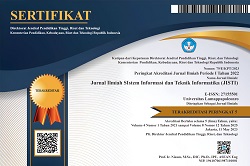Analisa Implementasi Sistem Informasi Dalam Demand Side Management Pada Gardu Induk Terhadap Faktor Beban
Abstract
In Demand Side Management (DSM) of Substation (GI), the application of information system can improve operational efficiency and optimize the distribution of electrical load. Siantan Substation (GI) is part of the Equatorial System, which is the electricity network in West Kalimantan. In 2019, GI Siantan's electricity usage by customers was still inefficient. This is especially true during peak load time (WBP), which is at 19.00. This research analyzes the implementation of information systems in demand side management (DSM) at Siantan Substation and its effect on load factor. The research shows that the implementation of DSM can improve the operational efficiency and stability of the substation by reducing peak loads and organizing load distribution evenly. The low load factor value is definitely caused by the high energy usage during WBP, which is 0.843. However, there was a decrease in the peak load value after simulating the implementation of Demand Side Management (DSM) with the load shifting method, which resulted in the load factor value increasing to 0.9045. Although there are constraints in training and system integration, the financial and operational benefits are substantial.
Downloads
References
Dzyuba, Anatoly., Irina Solovyera. (2020). Price-based Demand Side Management Model for Industrial and Large Electricity Consumers. International Journal of Energy Economics and Policy, Vol. 10. Issue 4. 2020. https://doi.org/10.32479/ijeep.8982
Javor, Dario., Aleksandar Janjic. (2016). Application of Demand Side Management Techniques in Successive Optimization Procedures. CDQM, An Int. J., Volume 19, November 4,2016, pp. 40-51
Logenthiran, Thilainathan., dkk. (2014). Demand Side Management of Smart Grid: Load Shifting and Incentives. Journal of Renewable Energy 6, 033136 (2014). http://dx.doi.org/10.1063/1.4885106
N, Trupti V., Dr.Ezhilarasan G. (2020). Analysis of Energy Consumption by Load Factor. JETIR February 2019, Volume 6, Issue 2, Issn -2349-6162
Nakano, SATOSHI., Ayu Washizu. (2020). On The Acceptability of Electricity Demand Side Management by Time of Day. Doi: 10.3390/en13143665
Niharika., Vivekananda Mukherjee. (2018). Day A Head Demand Side Management Using Symbiotic Organism Search Algorithm. IET Gener. Transm. Distrib., 2018, Vol. 12 iss. 14, pp. 3487-3494
U, Eze C., dkk. (2016). A New Proposed Demand Side Management Technique. IJESET, May 2016 Volume 8, Issue 6, pp: 271-281
JISTI
















